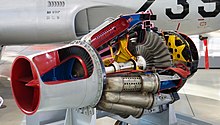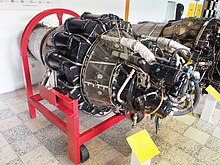General Electric J33
The General Electric J33 (also General Electric I-40 and Allison J33 ) was a turbojet engine based on the General Electric J31 . In contrast to this, however, the flow to the turbine was simplified by the fact that the combustion chambers were straight. In its execution it corresponds to the de Havilland Goblin .
history

development
The first test run of the engine, which initially bore the name General Electric I-40 , took place on January 13, 1944. The development from the General Electric I-16 was directed by the engineer Reginald G. Standerwick, who had worked for General Electric for over 30 years .
On June 16, 1944, the second prototype of the Lockheed P-80 Shooting Star , the XP-80A , flew for the first time with the I-40 as a drive. The engine was still very unreliable at that time - the test pilot Milo Burcham died on October 20, 1944 when his XP-80A crashed at Burbank as a result of problems with the fuel pump. The test pilot Tony LeVier was seriously injured on March 20, 1945 while landing with the rescue parachute after the fuselage of his XP-80A was destroyed by torn turbine blades. The popular fighter pilot Major Richard Bong died on August 6, 1945 near Burbank after a crash with a P-80 ; also after problems with the fuel pump.
General Electric outsourced series production to Allison in November 1945 , so the engine is also known as the Allison J33 .
The J33 remained the only engine with a centrifugal compressor developed by the United States. Other radial engines that were used in US aircraft were licensed British developments, such as. B. the Pratt & Whitney J42 and Pratt & Whitney J48 , each from Rolls-Royce .
commitment
The General Electric J33 was the first turbojet engine that was available in large numbers for US aircraft construction and that also powered the USA's first large-scale jet fighter - the Lockheed P-80 .
On January 26, 1946, pilot Col. WH Council flew a P-80 with this engine and two tip tanks enlarged to 300 gal. (1360 liters) each without refueling from Long Beach Airport in Los Angeles to LaGuardia Airport in New York City . With a flight time of 4 hours, 13 minutes, 26 seconds and an average speed of 584.82 mph 584.82 mph (941 km / h) it reached a new transcontinental record, which was not broken until 1949 by a Boeing B-47 Stratojet . Two more P-80s took off almost simultaneously with normal tip tanks, each made a stopover for quick refueling at the then Topeka Army Airfield ( US state of Kansas ) and reached the non-stop aircraft shortly after - 10 and 21 minutes later - LaGuardia Airport. With that, all three had undercut the previous record time.
On June 19, 1947, an aerodynamically improved one-off P-80 , the P-80R, reached an official world speed record of 1003.60 km / h (623.753 mph) over Muroc Army Air Field (now Edwards Air Force Base ) in California . The modified Allison J33-A-21 engine achieved 22.6 kN (5079 lb) of thrust with enlarged air inlets, with cooling of the intake air and with afterburner and enabled the pilot Col. Albert Boyd to return the record to the USA after 24 years to fetch. The P-80R only used the entire tank capacity of 300 gal. (1360 liters) of the mixture of 40% methanol and 60% water carried for this purpose within 15 minutes to cool the intake air - more than the kerosene that was also used as fuel.
In the Lockheed T-33 jet trainer , the engine remained in regular use until 2010 and continues to be operated as a vintage aircraft.
Production and maintenance
The engines were used exclusively for military purposes. The construction and choice of materials was continuously improved during the construction period at Allison; for example from version J-33-9 to version J-33-21 in over 30 points. The initially extremely short TBO - in 1945 with less than 20 operating hours - could be increased to 500 hours by 1950.
technology
construction
It is a single-shaft engine with a single-stage centrifugal compressor . The combustion air was fed through 14 individual combustion chambers to the single-stage axial turbine .
In the Lockheed F-94 , the engine was equipped with an afterburner and delivered up to 26.7 kN of thrust.
The fuel pump, the generator - which also served as the starter - and the hydraulic pump were located in front of the engine.
business
The engine presented the pilots, who were used to dealing with highly developed and optimized piston engines, with completely new challenges in flight operations. The starting process had to be followed and monitored exactly, the throttle response was very hesitant, the take-off taxiways - e.g. B. in the P-80 - were over 1.2 kilometers long, the fuel consumption was extremely high on the ground while taxiing and even at low altitudes.
“Taxi time should be cut to the absolute minimum. The fuel consumption while taxiing is about the same, in gallons per hour, as the fuel consumption during maximum range cruising at 35,000 feet. "
Use (selection)
Experimental aircraft and prototypes
- Convair XP-81 : Two prototypes, a General Electric J33-GE-5 and a General Electric T31 propeller turbine , first flight on February 11, 1945.
- Bell XP-83 : Two prototypes, two General Electric J33-GE-5s , first flight on February 25, 1945.
- Convair XF-92 : A prototype, an Allison J33-A-23 , first flight on September 18, 1948.
Production aircraft
Jet-only aircraft
- Lockheed P-80 Shooting Star : 1715 aircraft.
- Lockheed T-33 T-Bird : over 6,500 aircraft.
- Lockheed F-94 Starfire : 466 aircraft (not F-94C).
Mixed-propulsion aircraft
- North American AJ Savage : 143 aircraft. Two radial engines and an Allison J33-A-10 in the rear fuselage.
- Martin P4M Mercator : 21 planes. Two radial engines Pratt & Whitney R-4360-20A with 3,250 HP each (approx. 2,390 kW) and two Allison J33-A-23 with 20.5 kN each. A piston engine and a turbojet were each housed in a common engine nacelle.
Cruise missiles
- MGM-1 Matador : over 1200 units.
- MGM-13 Mace
- SSM-N-8A Regulus
Technical specifications

| Parameters | Data of the J33-A-23 (1949) | Data of the J33-A-33 (1951) | Data of the J33-A-35 (1953) |
|---|---|---|---|
| compressor | single-stage radial | ||
| turbine | single-stage axial | ||
| Weight | 1,775 lb (approx. 810 kg ) | 1,786 lb (approx. 810 kg ) | 1,820 lb (approx. 830 kg ) |
| Thrust without an afterburner | 4600 lb (20.5 kN) | 4600 lb (20.5 kN) | 5200 lb (23.1 kN) |
| Max. rotational speed | 11,750 min -1 | 11,750 min -1 | 11,750 min -1 |
Web links
- John Foster: Design Changes In J-33 Turbojet. In: Engineering & Production. Aviation Week, August 18, 1947, p. 20 , accessed on March 29, 2019 .
Individual evidence
- ↑ Allison (General Electric) J33-A-37 Turbojet Engine. In: National Air and Space Museum. Smithsonian Institution, accessed March 29, 2019 .
- ↑ Shooting Star Powerplant. In: Production. Aviation Week, February 11, 1946, p. 24 , accessed April 28, 2019 .
- ↑ Milo Burcham Killed. In: Aviation News. Aviation Week, October 30, 1944, p. 9 , accessed April 2, 2019 .
- ↑ Bryan R. Swopes: March 20, 1945. In: This Day in Aviation. March 20, 2019, accessed on April 2, 2019 (with detailed sectional drawing of the engine).
- ↑ Jet Turbo Problems. In: Headline News. Aviation Week, August 27, 1945, p. 16 , accessed on April 2, 2019 .
- ↑ Bong, Richard Ira. National Aviation Hall of Fame , accessed April 4, 2019 : "On Aug. 6th, 1945, in a test flight of the P-80 his plane exploded and Bong was killed."
- ↑ Allison J33 Turbojet. In: US Air Force Fact Sheet. National Museum of the United States Air Force , May 5, 2015, accessed March 26, 2019 .
- ↑ The Mighty B-47. In: Flying, August 1949. Flying, August 1949, p. 64 , accessed on April 20, 2019 (English): “Last February 8, the B-47 started the country by setting a new transcontinental speed record of 8 hr. 46 min. "
- ^ That P-80 Flight. In: Flying, April 1946. Flying, April 1946, pp. 44-45 , accessed on April 20, 2019 (English).
- ↑ a b Lockheed P-80R. In: US Air Force Fact Sheet. National Museum of the United States Air Force , October 9, 2015, accessed April 20, 2019 .
- ^ G. Geoffrey Smith: The World Speed Record. (PDF) Britain Temporarily Robbed by American Shooting Star. In: Flight, June 26th, 1947. Flight , June 26, 1947, pp. 596–597 , accessed on April 19, 2018 (English): “[…] single Allison Model 400 turbo-jet and was assisted by the first use of water methanol sprayed through the screen of the compressor, and also by after burning of the exhaust efflux. "
- ↑ Western US 2019 Airshows Calendar & Events with Ace Maker Appearances. Ace Maker Airshows, accessed April 11, 2019 .
- ^ John Foster: Design Changes In J-33 Turbojet. In: Engineering & Production. Aviation Week, August 18, 1947, p. 22 , accessed April 18, 2019 .
- ^ J-35 Points Up New Trust Achievements. In: Aeronautical Engineering. Aviation Week, April 2, 1951, pp. 25-29 , accessed April 4, 2019 .
- ↑ a b Pilot's Flight Operating Instructions for Army Model P-80A-1 Airplane. (PDF) April 25, 1945, accessed on April 14, 2019 (English, 43-page flight manual).
- ↑ US Gas Turbines Engines. In: Manufacturing. Aviation Week, February 28, 1949, p. 23 , accessed on March 26, 2019 .
- ↑ US Gas Turbines Engines. In: Manufacturing. Aviation Week, February 26, 1951, p. 45 , accessed on March 21, 2019 .
- ↑ US Gas Turbines Engines. In: Manufacturing. Aviation Week, March 2, 1953, p. 230 , accessed March 26, 2019 .



